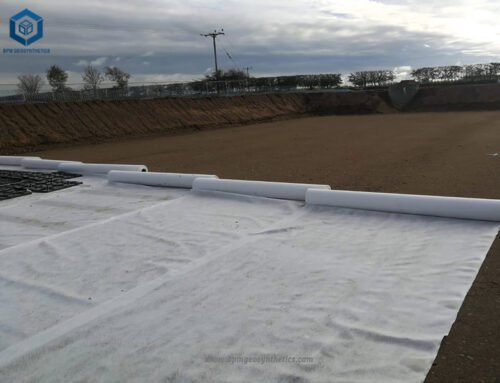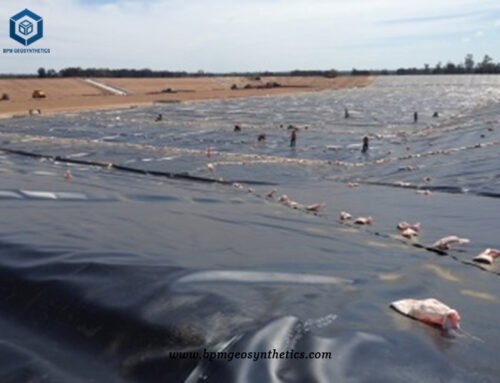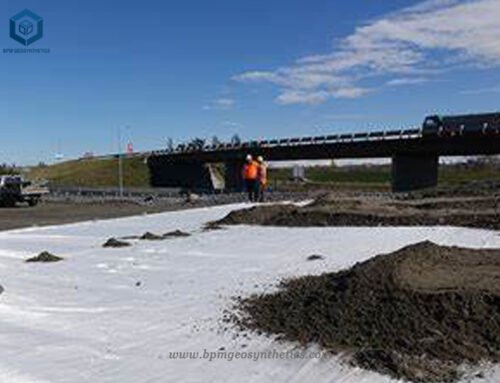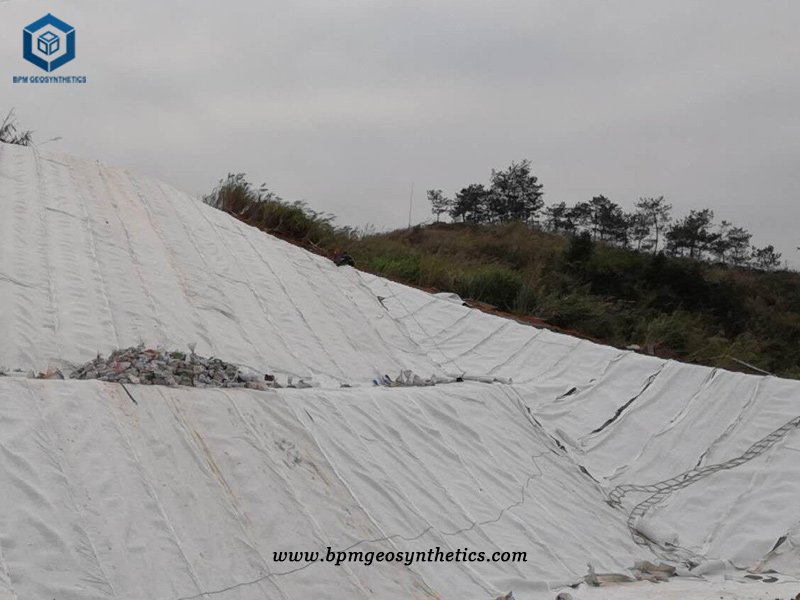
Geocomposite Drain Layer, also known as drainage net or drain net, is composed of plastic geo net with double-sided composite geotextiles for filtration. The geocomposite drain net can create a drainage structure that can be used between layers of geomembranes, between layers of soil, and in many other situations. The geocomposite drain layer can replace the traditional sand and gravel layer where requires geocomposite drainage filtration to keep silt and soil particles from clogging the flow or to increase the friction characteristics. It is mainly used for the drainage of landfill, roadbed and tunnel inner wall.
In railway, highway and other transportation infrastructure, the safety and service life of the project is closely related to its own drainage system, in which the gecomposite drainage layer is an important part of the drainage system, and it is a new geosynthetic composite material. The structure is a geonet core with filament nonwoven geotextiles glued on both sides. The geonet core consists of a thick vertical rib and oblique rib at the top and bottom. Groundwater, which can quickly drain off roads, also has a pore-maintenance system of its own that blocks capillary water under load. At the same time, it can also play a role in isolation and foundation reinforcement providing a complete “filter – drain – protection” effect.
Functions of Geocomposite Drainage Layer
- The geocomposite drainage layer is laid between the foundation and upper asphalt layer, it is helpful to discharge the water between the foundation and the foundation, block the capillary water and combine it effectively to the edge drainage system. This structure automatically shortens the drainage path of the foundation, and the drainage time is greatly reduced, and the use of selected foundation materials can be reduced, which can extend the service life of the road.
- The laying of geocomposite drainage layer can prevent the fine sand material from entering the base soil and play an isolation role.
- The road aging, crack formation, most of the rainwater will enter the section. In this case, the composite drainage geonet is directly laid under the road surface to replace the drainable foundation.
Performance of composite drainage geonet
- Strong water drainage.
- High tensile strength.
- drainage geonet core can reduce the probability of geotextile embedded in the geonet core, adhere to a long time of stable drainage.
- Can accept high pressure load for a long time.
- Corrosion resistance, acid and alkali resistance, long service life.
- Convenient construction, shorten construction period and reduce cost.
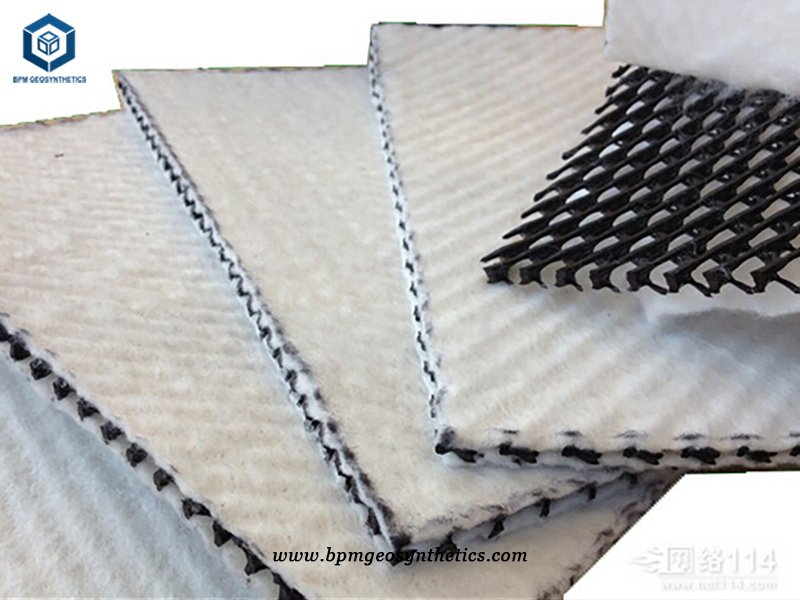
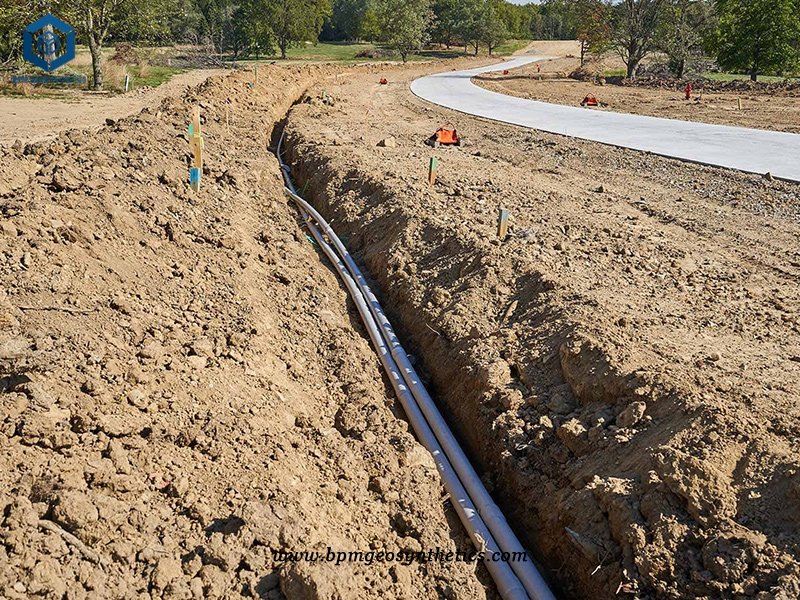
As the country with the most excellent economic foundation in sub-Saharan Africa, Kenya is honored as one of the countries with the most potential market in Africa. In its Vision 2030 plan, the Kenyan government has identified energy, infrastructure and construction, agriculture, manufacturing, mining, tourism, wholesale and retail, financial services and information industries as priority areas for development. Road projects are an important part of Kenya’s plan to build 10,000 kilometers of rural roads, all located in central Kenya. The construction contents include construction of subgrade earthwork, natural sand gravel base, cement stabilized sand gravel base and asphalt double-surface pavement, construction of pipes and culverts, box culverts and drainage system upgrading, etc.
The contractor of the highway project contacted our BPM salesman through the BPM website when bidding, and introduced the situation and demand of the project in detail. According to the geographical environment of the customer’s project and the carrying capacity of the highway, the BPM salesman recommended the composite drainage geonet with 7mm geonet core and composite 200gsm filament geotextile to the customer.
BPM immediately arranged the geocomposite drainage layer samples for the customer, and the customer requested to show the test report and sent the geocomposite drainage net samples for testing. The product test report is usually ensured and released by the third party testing company for testing at the time of production to ensure the quality of each batch.
We provided customers with samples of three dimensional composite drainage net, the customer tested, the perfect solution to the customer put forward various requirements, such as reinforcing the foundation, drainage smooth, cost savings, plus the inspection report and the preferential benefit price, the customer won the bid, customers begin to purchase, the first phase of purchase quantity was 50,000 square meters, phase ii purchase quantity was 80000 square meters.
The purchase quantity of the first phase arrived at the site, and the customer encountered some problems during laying. We immediately arranged the BPM engineer to conduct video communication, and explained in detail the site construction matters needing attention and how to carry out the installation and construction. The customer successfully completed the geocomposite drainage layer installation. The client felt very happy with this cooperation and recognized our professional service ability.
How to install the composite drainage geonet?
- Adjust the direction of the geosynthetics so that the length of the material roll is perpendicular to the road.
- Composite drainage geonet must be terminated, and the geotextiles on the adjacent geotextile core are overlapped along the material roll.
- Connect the geotextile mesh cores of adjacent geotextile rolls with white plastic buckles or polymer straps to connect the material rolls.
- The direction of the lap geotextile should be consistent with the direction of the packing. If the geotextile is laid between the foundation and the bottom base, it should be connected by welding or stitching so that the upper layer of the lap geotextile is fixed.

About BPM
BPM has been specializing in delivering one stop geosynthetics products and solutions to worldwide customers since its foundation in 2007. BPM had provided many types of effective and state of the art geomembranes, geotextiles, geocells, geosynthetic clay liners (GCLs), drainage boards, geogrids to over 81 countries. Our main customers are from Australia, France, Sweden, UK, Hong Kong, Hungary, New Zealand, Poland, Mexico, Ecuador, Brazil, Pakistan, Bangladesh, Thailand, Vietnam, Malaysia, Indonesia, Singapore, Philippines, Sri Lanka, India, UAE, Saudi Arabia, Qatar, Kenya, Ghana, Ethiopia, Somalia, Nigeria, South Africa, Swaziland, Mongolia etc.


